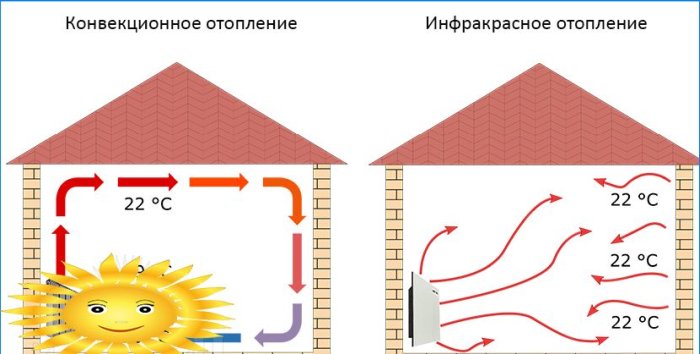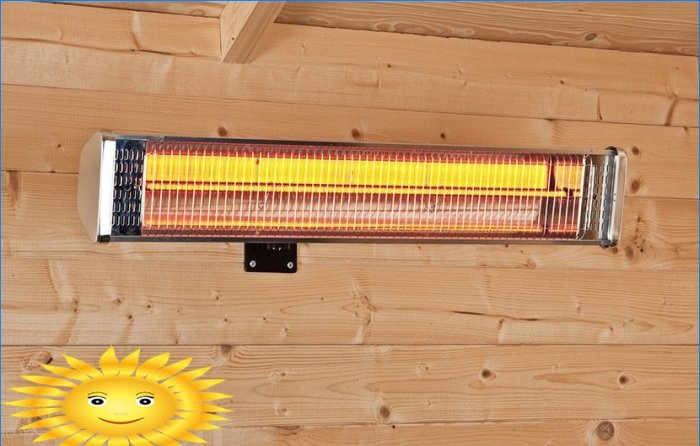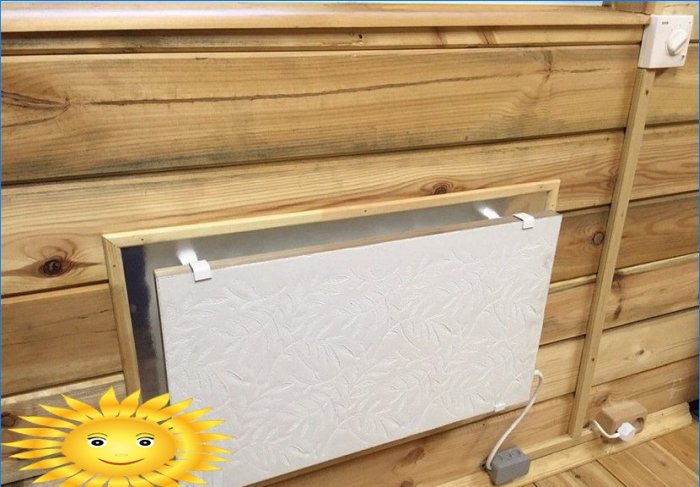Recommendation points
A quartz heater is a device that acts as an infrared emitter. There are two main types of electrical heating appliances that use the property of quartz to emit heat energy when heated. They have different designs, and each uses “its” part of the IR range.
The principle of operation of the IR emitter as a heater
There are three ways to transfer heat energy: conduction, radiation, and convection..
Room comfort is ensured by the temperature of the air, the enclosing internal surfaces (floor, walls, ceiling) and furniture. The task of any heater is to create and maintain this level of thermal comfort. The faster and more evenly the room heats up, the more efficient the operation of the heating device.
All types of heaters use the heat transfer methods listed above. But thermal conductivity is an “intrinsic property” of the heater materials that transfers energy from the heating element to the surface of the housing. And radiation and convection are directly responsible for heating, and they “work” in pairs. A hot or warm surface with a temperature higher than that of the environment generates infrared radiation, and it also creates conditions for convection. The efficiency of the heater largely depends on which method of heat transfer prevails..
If we talk about convection, then this is not the most optimal heating method. The same water heating batteries heat the room unevenly, and the natural transfer of heat by air and the heating of surrounding objects from it takes quite a long time.
Radiation is more effective in both ways. Infrared radiation heats the surrounding objects, and they, in turn, heat the air – the so-called “secondary convection”. The optimal temperature in the room is reached faster, and the air heats up evenly, while strong convection currents do not arise, as from one source, and dust does not spread.
Reflex Quartz Heaters
This type can be considered an improved version of the conventional infrared reflex heater with an open coil. Its difference is that the heating element is sealed in a sealed quartz glass flask. This simple technique eliminates oxygen combustion and extends the life of the coil..
There are two main versions: with a spiral made of refractory metals and carbon fiber. A feature of such a device can be considered high efficiency and low weight..
Heat from a reflex-type heater is felt immediately after it is turned on – the bulk of the energy is transmitted in the short-wave part of the IR range, does not “dissipate” in the air, has directional radiation and goes almost completely to heating the surfaces of the irradiated objects.
This type can be placed in a variety of locations, up to ceiling-mounted models.
The main disadvantage is the high temperature of the heating element. And although oxygen is not burned, the heater dries the air, and dust or organic matter (for example, insects or pet hair), falling on the surface, burns and spreads a characteristic odor.
Flat quartz heaters
Ceramic heating panels, namely flat quartz heaters, have a different device, different operating and temperature conditions.
The principle of operation itself was patented back in 1950. A structure of this type is a heating element immersed in a ceramic medium.
In the case of a quartz heater, this is a monolithic slab made of mortar, the main component of which is quartz sand. Naturally, the temperature conditions of the heating element should be low (so that it does not burn out itself and to preserve the ceramics).
What are the benefits:
- Safe case temperature. For a quartz heater, it does not exceed 95 ° C (that is, not higher than that of a water heating battery).
- Mode of operation that is gentle for the heating element. And, as a result, a high resource.
- Possibility of long-term continuous operation.
- Radiation of thermal energy falls on the long-wave (“softest”) part of the IR range.
- Due to the high heat capacity of the monolithic slab, the quartz heater cools down for a rather long time after disconnecting from the network. To some extent, by this property, it can be compared to a brick oven or a fireplace stove..
- Easy installation and maintenance. The flat “body” allows the quartz heater to be mounted to the walls. And the above advantages – to use as the main device in the heating system for summer cottages and small country houses.








What are the main advantages and disadvantages of using quartz heaters for electric heating in a house? Are they energy-efficient and safe to use? How do they compare to other types of electric heaters in terms of cost and effectiveness?